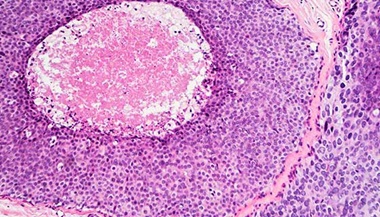Olfactory Neuroblastoma
When a cancer starts specifically in the nerves that affect your sense of smell, it is known as olfactory neuroblastoma. (Esthesioneuroblastoma is another name for this type of cancer.) An olfactory neuroblastoma often happens on the roof of the nasal cavity. It involves the cribriform plate, which is a bone between the eyes and located deep in the skull. Olfactory neuroblastoma is a rare form of cancer.
Symptoms
A number of symptoms and warning signs can indicate olfactory neuroblastoma:
-
Pain around the eyes
-
Stuffiness or congestion that worsens or doesn't improve
-
Blockage of the nose
-
Nasal drainage in the throat (postnasal drip)
-
Watery eyes
-
Nosebleeds
-
Pus from the nose
-
Face or tooth numbness
-
Loose teeth
-
Decreased sense of smell
-
Loss of or change in vision
-
Ear pain or pressure
-
Trouble opening the mouth
-
Enlarged lymph nodes in the neck
Esthesioneuroblastoma (Olfactory Neuroblastoma) | Angie’s Story
Diagnosis
A variety of different scanning techniques are helpful in examining the nasal cavity. These include X-rays, CT scans, and MRI. To gain additional information, your doctor may perform a biopsy. This is done by obtaining a tissue sample and examining it under a microscope to determine what kind of cancer is present.
Treatment
In most cases, the first treatment involved in a nasal cavity cancer, such as olfactory neuroblastoma, is surgery to remove the tumor. Often, this treatment is used to remove a wide swath of tissue around the cancer, as well, to help ensure that all the cancer has been removed. Wide local excision and medial maxillectomy are 2 procedures that are commonly done. These are invasive procedures that may require the reconstruction of part of the face, but these offer the best chance of long-term survival. In some instances, less invasive surgeries, such as endoscopic surgery using a thin flexible, lighted tube, might be possible.
Radiation therapy is also usually part of the treatment plan for olfactory neuroblastoma. This may be the primary treatment or it might be used after surgery to reduce the chances of the cancer returning. In some cases, chemotherapy may also be used to treat olfactory neuroblastoma.
You may need a combination of treatments involving radiation and chemotherapy after surgery to give you the best chance of survival.
Prevention
Research has found that people who are exposed to harmful chemicals and particles through work or other means have an increased risk of developing nasal cavity cancers. Some possible culprits include wood dust, flour, nickel and cadmium dust, glues, and formaldehyde and other solvents. Tobacco smoke may also be a contributing factor in developing an olfactory neuroblastoma. To protect yourself, avoid these substances as much as possible.
Managing olfactory neuroblastoma
Any cancer diagnosis is stressful, but there is hope for those with a diagnosis of olfactory neuroblastoma. The best thing you can do is be vigilant about your health and have a positive outlook about your treatments. Following a healthy diet and living as healthy a lifestyle as possible may play a role in your recovery, as well as preventing a recurrence of the cancer.






